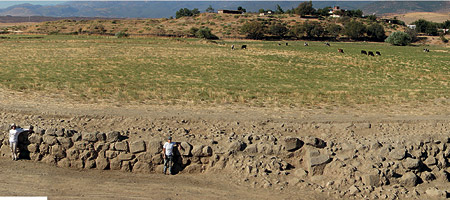Oriental Institute archaeologists follow up turn-of-the-century dig in city of Zincirli
By William HarmsNews Office
 The photo above shows a 150-foot portion of a wall at the Zincirli archaeological site in Turkey. Some members of the team who excavated the site during August and September pose in front of the ancient fortification during the dig. | |
Oriental Institute archaeologists are renewing exploration of a large, heavily fortified, ancient urban site in southeastern Turkey, which has not been excavated since a German team explored it more than a century ago.
Under the leadership of David Schloen, Associate Professor in the Oriental Institute, the Chicago archaeologists hope to uncover materials that will help scholars understand the transitions in the region that took place during the Bronze and Iron ages, during the collapse of the Hittite Empire and during the rise and fall of Assyrian power.
Located near a critical pass of the Amanus Mountain range, the city, known today as Zincirli, was once called Sam’al. The city was occupied before and during the Hittite Empire (ca. 1400-1200 B.C.) and was later taken over by an expanding Assyrian Empire. Eventually, the city was destroyed and abandoned in about 650 B.C.
Zincirli was the capital of a local kingdom, and served as a military and administrative center as well as a trading site. It includes a 20-acre citadel with palaces and other official buildings surrounded by a wall. An outer fortification wall made of stone and mud brick, with 100 towers jutting from it, formed a circle around the 100-acre site.
During the 2006 field season, the Oriental Institute team dug 150-foot-wide portion of the outer city wall to examine its basalt foundation. The wall was 15 feet wide and would have been 30 feet tall with its original mud-brick superstructure.
“Our initial work included making measurements to verify the records left by the Germans, who published extensive details of their excavation. We found that their work was quite good,” said Schloen.
The Germans excavated Zincirli from 1888 to 1902, and uncovered large reliefs adorned with inscriptions in Aramaic, Phoenician, Luwian and Akkadian. The reliefs are exhibited in Berlin and Istanbul museums.
Modern excavation techniques and advances in the science of archaeology will permit the Oriental Institute team to answer some important questions based on the evidence they will find at the site, Schloen said.
“We know much more now about how to use pottery as a way of dating layers in the site and for tracing patterns of interaction across the region,” he explained. In addition, archaeologists have developed more precise digging methods to separate layers and remnants of ancient buildings. New scientific instruments such as ground-penetrating radar also help archaeologists dig below the surface to examine building remains without excavating.
The Germans did not dig in the large lower city that surrounded the citadel; this area includes a wealth of Iron Age artifacts immediately below the surface. In addition to excavating houses, the Oriental Institute team will be able to map streets, workshops, markets and shrines to local gods.
![[Chronicle]](/images/sidebar_header_oct06.gif)